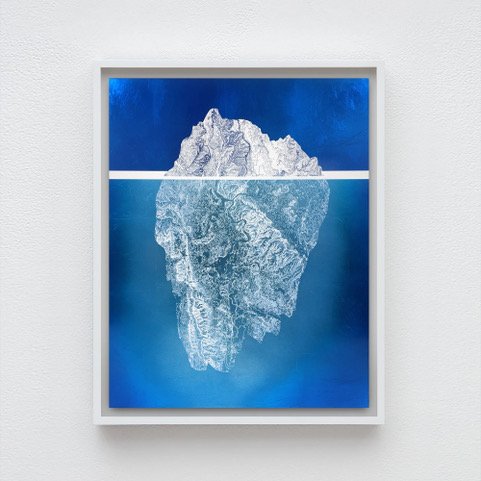Ewan David Eason
Ewan’s Mappa Mundi series – the title of which comes from the Medieval Latin Mappa, meaning sheet, and Mundi, of the world – has taken inspiration from the study of maps from ancient to modern. A particular reference point is Charles Booth’s 19th century ‘Poverty Maps’ which set out to define levels of poverty or wealth in London, street by street, using a colour coded system. Ewan’s stripping away of words and traditional symbolism echoes Booth’s work, with the solid colour blocks becoming abstract images in themselves. However, rather than defining the landscape as poor, middle class or rich, Ewan’s use of gold, with its sacred and precious quality, instead draws on the egalitarian nature of people.
Ewan’s Mappa Mundi series – the title of which comes from the Medieval Latin Mappa, meaning sheet, and Mundi, of the world – has taken inspiration from the study of maps from ancient to modern. A particular reference point is Charles Booth’s 19th century ‘Poverty Maps’ which set out to define levels of poverty or wealth in London, street by street, using a colour coded system. Ewan’s stripping away of words and traditional symbolism echoes Booth’s work, with the solid colour blocks becoming abstract images in themselves. However, rather than defining the landscape as poor, middle class or rich, Ewan’s use of gold, with its sacred and precious quality, instead draws on the egalitarian nature of people.
Ewan’s Mappa Mundi series – the title of which comes from the Medieval Latin Mappa, meaning sheet, and Mundi, of the world – has taken inspiration from the study of maps from ancient to modern. A particular reference point is Charles Booth’s 19th century ‘Poverty Maps’ which set out to define levels of poverty or wealth in London, street by street, using a colour coded system. Ewan’s stripping away of words and traditional symbolism echoes Booth’s work, with the solid colour blocks becoming abstract images in themselves. However, rather than defining the landscape as poor, middle class or rich, Ewan’s use of gold, with its sacred and precious quality, instead draws on the egalitarian nature of people.

